基于扩展卡尔曼滤波的自适应智能无人车辆行驶matlab仿真,输出三维动态行驶动画
目录
1.算法描述
2.仿真效果预览
3.MATLAB核心程序
4.完整MATLAB
1.算法描述
EKF扩展卡尔曼滤波要解决的是卡尔曼滤波不适用于非线性模型的问题。其和卡尔曼滤波算法结构相同,只是将非线性模型线性化,然后再应用卡尔曼滤波完成状态估计。
扩展卡尔曼滤波的初始化,需要将各个变量进行设置,对于不同的运动模型,状态向量是不一样的。为了保证代码对不同状态向量的兼容性,我们使用Eigen库中非定长的数据结构。初始化扩展卡尔曼滤波器时需要输入一个初始的状态量x_in,用以表示障碍物最初的位置和速度信息,一般直接使用第一次的测量结果。这两个公式求的是卡尔曼滤波器中一个很重要的量——卡尔曼增益K(Kalman Gain),用人话讲就是求差值y的权值。第一个公式中的R是测量噪声矩阵(measurement covariance matrix),这个表示的是测量值与真值之间的差值。一般情况下,传感器的厂家会提供。
扩展卡尔曼(EKF)与经典卡尔曼(KF)的区别在于测量矩阵H的计算。EKF对非线性函数进行泰勒展开后,进行一阶线性化的截断,忽略了其余高阶项,进而完成非线性函数的近似线性化。正是由于忽略了部分高阶项,使得EKF的状态估计会损失一些精度。
卡尔曼滤波作为连续状态空间问题的一种解决方案,已经成功运用在火星登陆和自动导弹制导等领域。本质上卡尔曼滤波(Kalman Filter)是一置信度为正态分布的贝叶斯(Bayes Filter)滤波器,它的置信度可以表示为一个均值向量和协方差矩阵的形式,均值向量表示可能的状态,协方差矩阵表示该状态的不确定度。
前提假设
卡尔曼滤波需要满足以下三个前提假设,才能保证在任意一个时刻t的置信度bel(x(t))都是正态分布:
1) 运动模型必须是一个线性高斯模型。也就是说t+1时刻的状态必须是t时刻的状态的线性函数,附加一个高斯随机噪声。
其中A是一个矩阵,Δ是运动向量,ξ是高斯随机噪声
2) 传感器模型也是一个线性高斯模型。
其中是一个矩阵,ζ表示传感器测量的高斯噪声。
3) 初始置信度bel(x0)是一个正态分布。
一维状态空间卡尔曼滤波
先从最简单的一维卡尔曼滤波说起,假设一辆小车以δ的速度和一定的随机噪声沿着一条直线前进,则它的运动方程:
针对于线性高斯系统,卡尔曼滤波高效、简单、易行,然而遗憾的是在实际问题中,这样的理想的场景非常少。于是又有了扩展卡尔曼滤波,扩展卡尔曼滤波的思想是非线性系统在均值的一个小的邻域内可以近似认为是线性的,从而可以得到一个近似的高斯置信度。
2.仿真效果预览
matlab2022a仿真结果如下:
3.MATLAB核心程序
%测试传感器融合跟踪
%在自我载具左侧经过的载具。场景
%模拟公路设置,其他车辆位于和前面
%在自我汽车后面。
scenario = drivingScenario;
scenario.SampleTime = 0.01;
% Rear-left-facing short-range radar sensor at the left rear wheel well of the car.
sensors{3} = radarDetectionGenerator('SensorIndex', 3, 'Height', 0.2, 'Yaw', 120, ...
'SensorLocation', [0, egoCar.Width/2], 'MaxRange', 30, 'ReferenceRange', 50, ...
'FieldOfView', [90, 5], 'AzimuthResolution', 10, 'RangeResolution', 1.25);
% Rear-right-facing short-range radar sensor at the right rear wheel well of the car.
sensors{4} = radarDetectionGenerator('SensorIndex', 4, 'Height', 0.2, 'Yaw', -120, ...
'SensorLocation', [0, -egoCar.Width/2], 'MaxRange', 30, 'ReferenceRange', 50, ...
'FieldOfView', [90, 5], 'AzimuthResolution', 10, 'RangeResolution', 1.25);
% Front-left-facing short-range radar sensor at the left front wheel well of the car.
sensors{5} = radarDetectionGenerator('SensorIndex', 5, 'Height', 0.2, 'Yaw', 60, ...
'SensorLocation', [egoCar.Wheelbase, egoCar.Width/2], 'MaxRange', 30, ...
'ReferenceRange', 50, 'FieldOfView', [90, 5], 'AzimuthResolution', 10, ...
'RangeResolution', 1.25);
% Front-right-facing short-range radar sensor at the right front wheel well of the car.
sensors{6} = radarDetectionGenerator('SensorIndex', 6, 'Height', 0.2, 'Yaw', -60, ...
'SensorLocation', [egoCar.Wheelbase, -egoCar.Width/2], 'MaxRange', 30, ...
'ReferenceRange', 50, 'FieldOfView', [90, 5], 'AzimuthResolution', 10, ...
'RangeResolution', 1.25);
%%创建跟踪程序
%创建一个||来跟踪
%靠近小我车的车辆。跟踪器使用
%|initSimDemoFilter|支持函数初始化恒速
%处理位置和速度的线性卡尔曼滤波器。
%
%跟踪以二维方式进行。虽然传感器返回三维测量值,
%运动本身仅限于水平面,因此没有
%需要跟踪高度。
tracker = multiObjectTracker('FilterInitializationFcn', @initSimDemoFilter, ...
'AssignmentThreshold', 30, 'ConfirmationParameters', [4 5], 'NumCoastingUpdates', 5);
positionSelector = [1 0 0 0; 0 0 1 0]; % Position selector
velocitySelector = [0 1 0 0; 0 0 0 1]; % Velocity selector
BEP = createDemoDisplay(egoCar, sensors);
toSnap = true;
while advance(scenario) && ishghandle(BEP.Parent)
% Get the scenario time
time = scenario.SimulationTime;
% Get the position of the other vehicle in ego vehicle coordinates
ta = targetPoses(egoCar);
% Simulate the sensors
detections = {};
isValidTime = false(1,6);
for i = 1:6
[sensorDets,numValidDets,isValidTime(i)] = sensors{i}(ta, time);
if numValidDets
detections = [detections; sensorDets]; %#ok
end
end
% Update the tracker if there are new detections
if any(isValidTime)
vehicleLength = sensors{1}.ActorProfiles.Length;
detectionClusters = clusterDetections(detections, vehicleLength);
confirmedTracks = updateTracks(tracker, detectionClusters, time);
% Update bird's-eye plot
updateBEP(BEP, egoCar, detections, confirmedTracks, positionSelector, velocitySelector);
end
% Snap a figure for the document when the car passes the ego vehicle
if ta(1).Position(1) > 0 && toSnap
toSnap = false;
snapnow
end
end
A111 4.完整MATLAB
V









